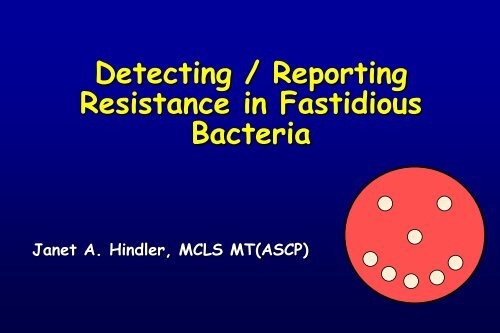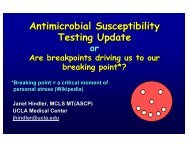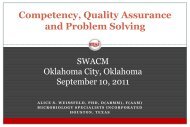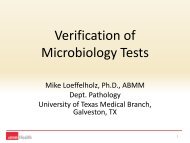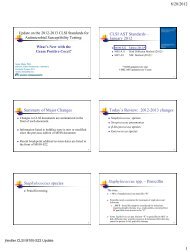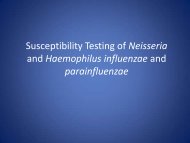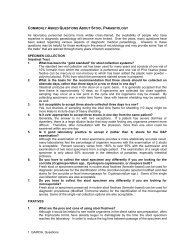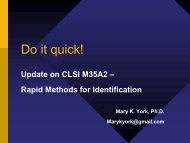Detecting Reporting Resistance in Fastidious Bacteria - SWACM
Detecting Reporting Resistance in Fastidious Bacteria - SWACM
Detecting Reporting Resistance in Fastidious Bacteria - SWACM
Create successful ePaper yourself
Turn your PDF publications into a flip-book with our unique Google optimized e-Paper software.
<strong>Detect<strong>in</strong>g</strong> / <strong>Report<strong>in</strong>g</strong><br />
<strong>Resistance</strong> <strong>in</strong> <strong>Fastidious</strong><br />
<strong>Bacteria</strong><br />
Janet A. H<strong>in</strong>dler, MCLS MT(ASCP)
CLSI M45-A2 Guidel<strong>in</strong>e<br />
“Methods for Antimicrobial<br />
Dilution and Disk Susceptibility<br />
Test<strong>in</strong>g of Infrequently Isolated<br />
or <strong>Fastidious</strong> <strong>Bacteria</strong>”<br />
M45-A2 August 2010<br />
M45-A May 2006<br />
M45-P Oct. 2005
CLSI M45-A2 Guidel<strong>in</strong>e<br />
Abiotrophia / Granulicatella Lactobacillus<br />
*Aeromonas / Plesiomonas Leuconostoc<br />
Bacillus spp. (not anthrax)<br />
Listeria monocytogenes<br />
*Campylobacter jejuni / coli *Moraxella catarrhalis<br />
Corynebacterium<br />
Erysipelothrix<br />
HACEK Group<br />
Helicobacter pylori<br />
*Pasteurella<br />
Pediococcus<br />
*Vibrio spp. (<strong>in</strong>cl. cholera)<br />
Potential <strong>Bacteria</strong>l Agents<br />
of Bioterrorism<br />
* disk diffusion method described <strong>in</strong> addition<br />
to reference MIC method
When should we test M45 organisms?<br />
“Test<strong>in</strong>g should ONLY be undertaken<br />
<strong>in</strong> consultation with <strong>in</strong>fectious disease<br />
or other expert cl<strong>in</strong>icians that can<br />
assist <strong>in</strong> determ<strong>in</strong><strong>in</strong>g if susceptibility<br />
test<strong>in</strong>g is needed <strong>in</strong> the management<br />
of a specific patient and <strong>in</strong> the<br />
<strong>in</strong>terpretation of any results<br />
generated.”<br />
CLSI M45-A2<br />
Section 5
Organisms Included <strong>in</strong><br />
CLSI M45-A2<br />
May not require treatment<br />
– Some often “normal flora” (e.g.,<br />
Corynebacterium spp., Lactobacillus spp.)<br />
– Some environmental organisms (e.g., Bacillus<br />
spp.)<br />
Generally, test isolates from sterile<br />
sites only<br />
– But even for isolates from sterile sites, test<strong>in</strong>g<br />
may not be needed as <strong>in</strong>fections often treated<br />
empirically…respond to drugs of choice
Empiric Therapy Recommendations<br />
Order ($$) at: medicalletter.org<br />
2007<br />
2010<br />
Order ($$) at: sanfordguide.com
Table 17. Summary of Test<strong>in</strong>g Conditions and<br />
QC Recommendations for Infrequently<br />
Isolated or <strong>Fastidious</strong> <strong>Bacteria</strong><br />
CLSI M45-A2<br />
Table 17
Recommended Media M45-A2<br />
(Broth microdilution MIC)<br />
Pla<strong>in</strong> Mueller H<strong>in</strong>ton broth<br />
– Aeromonas, Plesiomonas, Vibrio, Bacillus, M. catarrhalis,<br />
some BT agents<br />
Mueller H<strong>in</strong>ton + 2.5-5% lysed horse blood –<br />
same as recommendation for streptococci<br />
– Abiotrophia/Granulicatella (+0.001% pyridoxal),<br />
Campylobacter, Coryneforms and Corynebacterium spp.,<br />
Erysipelothrix, HACEK, Lactobacillus, Leuconostoc,<br />
Listeria, Pasteurella, Pediococcus<br />
(some need CO 2 or other special <strong>in</strong>cubation atmosphere<br />
and/or extended <strong>in</strong>cubation)<br />
Other<br />
– Helicobacter pylori, some BT agents
Can we test M45-A2 organisms with a<br />
commercial AST system?<br />
Disk diffusion - OK<br />
– Number of drug/bugs for which disk diffusion method<br />
is described is limited<br />
MICs limited<br />
– Few tests FDA cleared for M45-A2 organisms; low<br />
range of drug concentrations may not be available<br />
If NOT FDA cleared<br />
– Confirm reliability by perform<strong>in</strong>g <strong>in</strong> house verification /<br />
validation<br />
– Qualify results<br />
Remember: if you cannot confidently test <strong>in</strong> your<br />
laboratory, SEND to a reliable reference<br />
laboratory
What commercial AST systems<br />
might we use?<br />
Etest or commercial broth microdilution MIC<br />
system<br />
– Perform test accord<strong>in</strong>g to manufacturer’s<br />
recommendations; use manufacturer’s QC ranges<br />
For Etest - check technical <strong>in</strong>formation and<br />
references<br />
– Etest lists some breakpo<strong>in</strong>ts for M45 organisms, some<br />
of which differ from those of CLSI<br />
Note: the extent to which commercial systems have been<br />
evaluated for most M45-A2 organisms is very limited<br />
CLSI does not endorse commercial test systems
Qualify<strong>in</strong>g Results<br />
Optional Comments<br />
“Test<strong>in</strong>g performed per Dr. Jones<br />
request”<br />
“Infectious Disease consult suggested”<br />
“Test<strong>in</strong>g performed us<strong>in</strong>g a method that<br />
is not FDA cleared for test<strong>in</strong>g Abiotrophia<br />
spp. but was validated <strong>in</strong> this laboratory”<br />
Consider for All M45 organism AST reports ….follow<strong>in</strong>g<br />
discussion with medical staff and review of request /<br />
organism / drugs / results / method<br />
Note: Will not <strong>in</strong>clude on all examples <strong>in</strong> this talk due to space.
Specimen: Blood<br />
Diagnosis: Endocarditis<br />
Abiotrophia spp.<br />
Should we perform AST?<br />
What method?<br />
What drugs?
Abiotrophia spp. / Granulicatella spp. (1)<br />
Nutritionally variant streptococci<br />
Requires 0.001% (1 µg/ml) pyridoxal hydrochloride<br />
– Add 5 µl of 20 µg/ml solution to 100 µl of drug <strong>in</strong><br />
microdilution well (CAMHB + 2.5-5% LHB)<br />
May show decreased penicill<strong>in</strong> susceptibility… can<br />
cause difficulties <strong>in</strong> treat<strong>in</strong>g endocarditis<br />
– Comb<strong>in</strong>ation therapy with penicill<strong>in</strong> or vancomyc<strong>in</strong> plus<br />
am<strong>in</strong>oglycoside often prescribed…or 3 rd or 4 th generation<br />
cephalospor<strong>in</strong><br />
– May require surgical <strong>in</strong>tervention<br />
Many labs may not separate two genera<br />
– Genus identification not critical to guide therapy
Baddour et al. 2005. Circulation. 111:e394-434.
CLSI M45-A2 Table 1<br />
Abiotrophia / Granulicatella
Drugs to Test / Report<br />
“Agents to Consider for Primary<br />
Test<strong>in</strong>g”<br />
Other agents listed that might be<br />
useful for a specific patient<br />
“In consultation with the cl<strong>in</strong>ician<br />
car<strong>in</strong>g for the patient, a priority list of<br />
critical drugs for a specific patient’s<br />
isolate can be developed”<br />
CLSI M45-A2<br />
Section 6.1
CLSI M45-A2 Table 1<br />
Abiotrophia / Granulicatella<br />
Derivation of <strong>in</strong>terpretive criteria (breakpo<strong>in</strong>ts)….
How were <strong>in</strong>terpretive criteria<br />
(breakpo<strong>in</strong>ts) established?<br />
Searched literature<br />
Surveyed experience of work<strong>in</strong>g group<br />
members<br />
Performed limited studies<br />
Adapted breakpo<strong>in</strong>ts from similar bugs <strong>in</strong><br />
M100, when appropriate<br />
Did NOT use extensive microbiological,<br />
cl<strong>in</strong>ical, and pharmacodynamic databases<br />
that are typically used to set breakpo<strong>in</strong>ts<br />
(described <strong>in</strong> CLSI M23 document)
“S” only breakpo<strong>in</strong>t<br />
Abiotrophia spp. – Vancomyc<strong>in</strong><br />
MIC (µg/ml)<br />
Susc Int Res<br />
vancomyc<strong>in</strong> 1.0 - -<br />
<strong>in</strong>vestigate any NS isolate<br />
..Repeat ID and AST<br />
..Save isolate<br />
..Send to reference lab (test by CLSI reference MIC method)<br />
CLSI M45-A2<br />
Table 1
Specimen: Blood<br />
Diagnosis: Endocarditis<br />
Abiotrophia spp.<br />
Test performed with<br />
CLSI Reference Method<br />
Report Example<br />
MIC (µg/ml)<br />
ceftriaxone<br />
penicill<strong>in</strong><br />
vancomyc<strong>in</strong><br />
2.0 I<br />
1.0 I<br />
0.5 S<br />
“Test<strong>in</strong>g performed per Dr. Jones request.”<br />
Infectious Disease consult suggested.
Specimen: Blood<br />
Diagnosis: Endocarditis<br />
Abiotrophia spp.<br />
ceftriaxone<br />
penicill<strong>in</strong><br />
vancomyc<strong>in</strong><br />
Test performed with Etest<br />
Report Example<br />
MIC (µg/ml)<br />
2.0 I<br />
1.0 I<br />
0.5 S<br />
“Test<strong>in</strong>g performed per Dr. Jones request. Test<strong>in</strong>g<br />
performed by a method that is not FDA cleared for test<strong>in</strong>g<br />
Abiotrophia spp. but was validated <strong>in</strong> this laboratory.<br />
Infectious Disease consult suggested.”
Specimen: Bone marrow<br />
Diagnosis: Leukemia<br />
Corynebacterium spp.<br />
Should we perform AST?<br />
What method?<br />
What drugs?
Coryneforms and<br />
Corynebacterium spp.<br />
Includes:<br />
– Corynebacterium spp.<br />
– Coryneforms - Arcanobacterium, Arthrobacter,<br />
Brevibacterium, Cellulomonas, Cellulosimicrobium,<br />
Corynebacterium, Dermabacter, Leifsonia,<br />
Microbacterium, Oerskovia, Rothia, Turicella, and<br />
aerotolerant Act<strong>in</strong>omyces such as A. naeslundii, A<br />
odontolyticus, A neuii<br />
<strong>Resistance</strong><br />
– C. jekeium, C. urealyticum most “R” Corynebacterium<br />
spp.<br />
– Variety of results for other species<br />
-lactam “S” results should not be reported until<br />
48 h
Specimen: Bone marrow<br />
Diagnosis: Leukemia<br />
Corynebacterium spp.<br />
MIC (µg/ml)<br />
erythromyc<strong>in</strong> > 2 R<br />
gentamic<strong>in</strong> 1 S<br />
penicill<strong>in</strong> -<br />
vancomyc<strong>in</strong> 1 S<br />
24 h prelim<strong>in</strong>ary<br />
results<br />
(pen ≤ 0.5 µg/ml)<br />
“Penicill<strong>in</strong> results pend<strong>in</strong>g”
Specimen: Bone marrow<br />
Diagnosis: Leukemia<br />
Corynebacterium spp.<br />
MIC (µg/ml)<br />
erythromyc<strong>in</strong> > 2 R<br />
gentamic<strong>in</strong> 1 S<br />
penicill<strong>in</strong> 0.5 S<br />
vancomyc<strong>in</strong> 1 S<br />
48 h f<strong>in</strong>al<br />
results
Specimen: Dog bite<br />
Diagnosis: Localized abscess<br />
Pasteurella multocida<br />
Should we perform AST?<br />
What method?<br />
What drugs?
CLSI M45-A2 Table 13<br />
Pasteurella spp. (1)
CLSI M45-A2 Table 13<br />
Pasteurella spp. (2)<br />
Additional <strong>in</strong>formation <strong>in</strong>clud<strong>in</strong>g test for -lactamase…..
Why should we do -lactamase test on P.<br />
multocida from “normally sterile and<br />
respiratory sources” (vs. wounds)?<br />
Physicians might use a s<strong>in</strong>gle agent to<br />
treat <strong>in</strong>fections at “normally sterile and<br />
respiratory sites”<br />
In contrast, wounds are usually treated<br />
with agent that would cover for -<br />
lactamase produc<strong>in</strong>g organisms
Bite Wound Infections<br />
Common therapy: -lactam / -lactamase<br />
<strong>in</strong>hibitor (e.g., amoxicill<strong>in</strong>-clavulanic acid)<br />
– Covers -lactamase produc<strong>in</strong>g organisms<br />
Organisms commonly present that are<br />
sometimes -lactamase positive<br />
– Pasteurella multocida<br />
– Eikenella corrodens<br />
Organisms commonly present that are<br />
usually -lactamase positive<br />
– Staphylococcus aureus
-Lactamase Test<strong>in</strong>g of M45 Bugs<br />
Recommended for P. multocida, HACEK<br />
Use chromogenic cephalospor<strong>in</strong> (e.g.,<br />
nitrocef<strong>in</strong>)<br />
Positive reaction with<strong>in</strong> 5 m<strong>in</strong>utes<br />
(Lion, C. personal communication)<br />
+ _
Specimen: Cerebrosp<strong>in</strong>al fluid<br />
Diagnosis: Ventricular shunt <strong>in</strong>fection<br />
Prelim<strong>in</strong>ary report:<br />
alpha hemolytic streptococcus-like colonies<br />
(patient <strong>in</strong>itially treated with vancomyc<strong>in</strong><br />
without significant improvement)<br />
F<strong>in</strong>al report:<br />
Leuconostoc spp.<br />
(patient switched to penicill<strong>in</strong>)
Specimen: Cerebrosp<strong>in</strong>al fluid<br />
Diagnosis: Ventricular shunt <strong>in</strong>fection<br />
Leuconostoc spp.<br />
penicill<strong>in</strong><br />
MIC (µg/ml)<br />
2 S<br />
“Leuconostoc spp. are <strong>in</strong>tr<strong>in</strong>sically resistant<br />
to vancomyc<strong>in</strong>. Infectious Disease consult<br />
suggested.”
Vancomyc<strong>in</strong>-R Gram Positives<br />
(colonies may sometimes look like streptococci)<br />
Organism<br />
Vancomyc<strong>in</strong><br />
Vancomyc<strong>in</strong><br />
breakpo<strong>in</strong>ts?<br />
Erysipelothrix All “R” No<br />
Lactobacillus<br />
Some species “S”<br />
(e.g. L. acidophilus grp)<br />
Yes<br />
Leuconostoc All “R” No<br />
Pediococcus All “R” No
Procedure used <strong>in</strong> some labs to expedite<br />
identification of vancomyc<strong>in</strong>-R grampositive<br />
cocci…<br />
Gram sta<strong>in</strong>: GPC cha<strong>in</strong>s<br />
Drop vancomyc<strong>in</strong> disk on BAP subculture<br />
– Note: Not standardized procedure<br />
No zone and colony morphology<br />
consistent with vancomyc<strong>in</strong>-R species –<br />
report “presumptive” vancomyc<strong>in</strong><br />
resistance<br />
– Vancomyc<strong>in</strong> often used empirically for suspected<br />
gram-positive organism <strong>in</strong>fections
Some additional notes on the<br />
other CLSI M45-A2 organisms…
HACEK Group<br />
Haemophilus aphrophilus, H. paraphrophilus, H.<br />
segnis, Aggregatibacter (formerly Act<strong>in</strong>obacillus)<br />
act<strong>in</strong>omycetemcomitans, Cardiobacterium spp.,<br />
Eikenella corrodens, K<strong>in</strong>gella spp.<br />
Often associated with endocarditis<br />
– Previous treatment recommendation was ampicill<strong>in</strong> +<br />
gentamic<strong>in</strong><br />
– Increas<strong>in</strong>g numbers of -lactamase producers<br />
– Therapy now often recommend is cefotaxime / ceftriaxone<br />
Perform -lactamase test<br />
Some Haemophilus spp. and Act<strong>in</strong>obacillus spp.<br />
may be “R” to ampicill<strong>in</strong> by mechanisms other than<br />
-lactamase
MIC Test<strong>in</strong>g of HACEK<br />
CAMHB plus 2.5-5% lysed horse blood<br />
Some isolates may not grow well us<strong>in</strong>g<br />
recommended test<strong>in</strong>g conditions<br />
Ensure adequate growth <strong>in</strong> growth control<br />
well<br />
Sometimes growth enhanced with fresh<br />
and maximum amount (5%) of lysed horse<br />
blood
Specimen: Blood<br />
Diagnosis: Endocarditis<br />
Cardiobacterium spp.<br />
“Unable to obta<strong>in</strong> sufficient growth<br />
for antimicrobial susceptibility<br />
test<strong>in</strong>g.”
Specimen: CSF<br />
Diagnosis: men<strong>in</strong>gitis<br />
Listeria monocytogenes<br />
MIC ( g/ml)<br />
ampicill<strong>in</strong><br />
trimeth-sulfa<br />
1 S<br />
0.5/9.5 S<br />
“Infectious Disease consult suggested.<br />
Cephalospor<strong>in</strong>s are NOT effective aga<strong>in</strong>st Listeria<br />
monocytogenes”
Moraxella catarrhalis<br />
“If desired, -lactamase test<strong>in</strong>g can be performed, us<strong>in</strong>g<br />
chromogenic cephalospor<strong>in</strong> methods such as<br />
nitrocef<strong>in</strong>.” (>90% -lactamase positive)<br />
Respiratory <strong>in</strong>fections due to M. catarrhalis respond to<br />
drugs commonly prescribed (e.g., amoxicill<strong>in</strong>/clavulanic<br />
acid, macrolide) for respiratory tract <strong>in</strong>fections<br />
“Test<strong>in</strong>g may be useful for epidemiological purposes or<br />
for management of patients with prolonged or severe<br />
<strong>in</strong>fections.”<br />
In addition to MIC method, disk diffusion can now be<br />
used for: amoxicill<strong>in</strong>-clavulanic acid, azithromyc<strong>in</strong>,<br />
clarithromyc<strong>in</strong>, erythromyc<strong>in</strong>, tetracycl<strong>in</strong>e, and TMP-<br />
SMX<br />
CLSI M45-A2 Table 12
Antibiotic therapy<br />
Vibrio cholerae<br />
– An adjunct to fluid replacement<br />
– For severe cases (otherwise, mortality up to 60%)<br />
– Used to reduce duration of diarrhea and excretion<br />
of V. cholerae to control spread<br />
Drugs of choice for V. cholerae<br />
– Doxycycl<strong>in</strong>e<br />
– Fluoroqu<strong>in</strong>olone<br />
– Trimeth-sulfa (stra<strong>in</strong> 0139 is resistant)<br />
Sanford Guide, 2011
Outcomes of S<strong>in</strong>gle Dose Azithromyc<strong>in</strong> vs.<br />
Ciprofloxac<strong>in</strong> for Cholera <strong>in</strong> Adults<br />
Outcome<br />
Azithromyc<strong>in</strong><br />
(97 patients)<br />
Ciprofloxac<strong>in</strong><br />
(98 patients)<br />
P value<br />
Cl<strong>in</strong>ical successful 71(73)* 26 (27)
What about quality control?…
Table 17. Summary of Test<strong>in</strong>g Conditions and<br />
QC Recommendations for Infrequently<br />
Isolated or <strong>Fastidious</strong> <strong>Bacteria</strong><br />
CLSI M45-A2<br />
Table 17
Quality Control<br />
Adapted from M02, M07, M100 as much as possible<br />
Follow M02, M07 test<strong>in</strong>g/frequency<br />
recommendations<br />
QC ranges <strong>in</strong> M45-A2 same as <strong>in</strong> M100<br />
If already perform<strong>in</strong>g specific drug-organism QC as<br />
part of M100 test<strong>in</strong>g, no need to redo for M45-A2<br />
drug-organism<br />
– Example:<br />
S. pneumoniae ATCC 49619 is used to QC CAMHB-LHB<br />
(2.5-5% v/v) panel and weekly QC program <strong>in</strong> place<br />
Panel is used to test penicill<strong>in</strong> and P. multocida<br />
No supplemental QC needed for penicill<strong>in</strong>
M<strong>in</strong>imum Laboratory Requirements for<br />
Test<strong>in</strong>g Infrequently Isolated or<br />
<strong>Fastidious</strong> <strong>Bacteria</strong><br />
Performs disk diffusion AST at least once/week if<br />
test<strong>in</strong>g Aeromonas spp., Plesiomonas, spp. Vibrio<br />
spp., M. catarrhalis, Pasteurella spp., or<br />
Campylobacter by disk diffusion<br />
Performs broth microdilution MICs (visually read)<br />
at least once/week<br />
Possesses current CLSI M02, M07, and M100<br />
Laboratory coord<strong>in</strong>ated by director-level cl<strong>in</strong>ical<br />
microbiologist, ID MD or pathologist with expertise<br />
<strong>in</strong> antimicrobial susceptibility test<strong>in</strong>g<br />
CLSI M45-A2<br />
Section 9.1
Summary<br />
M45-A2 describes reference methods for test<strong>in</strong>g<br />
several types of <strong>in</strong>frequently isolated or fastidious<br />
bacteria<br />
M45-A2 organisms generally do not require AST<br />
because….<br />
– They may not be caus<strong>in</strong>g an <strong>in</strong>fection<br />
– Infections caused by them are often treated empirically<br />
AST of M45-A2 organisms should only be performed<br />
– Follow<strong>in</strong>g consultation with an Infectious Disease MD<br />
– In a laboratory that meets the qualifications suggested <strong>in</strong> M45-A<br />
Currently, there are no FDA cleared systems for<br />
test<strong>in</strong>g most of the organisms listed <strong>in</strong> M45-A2


